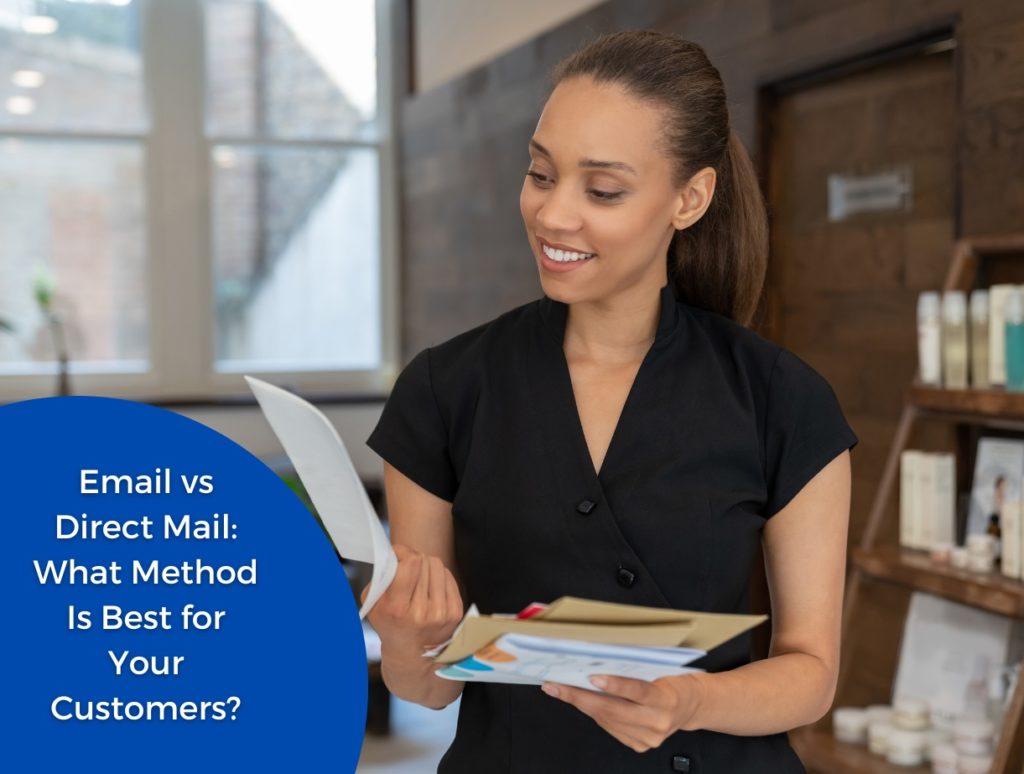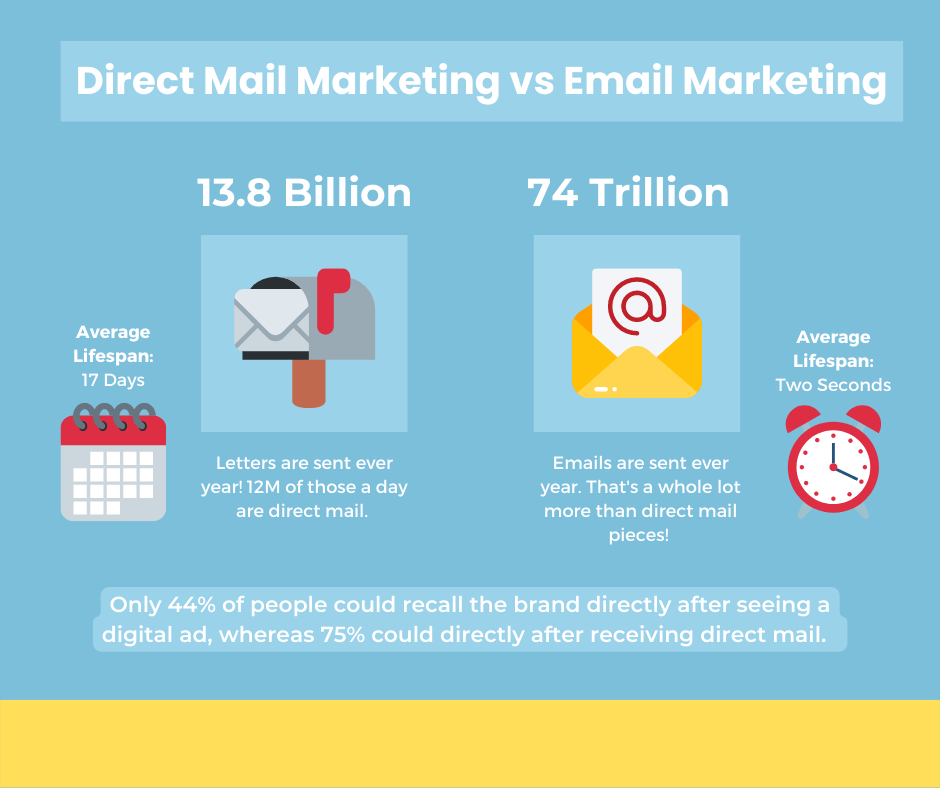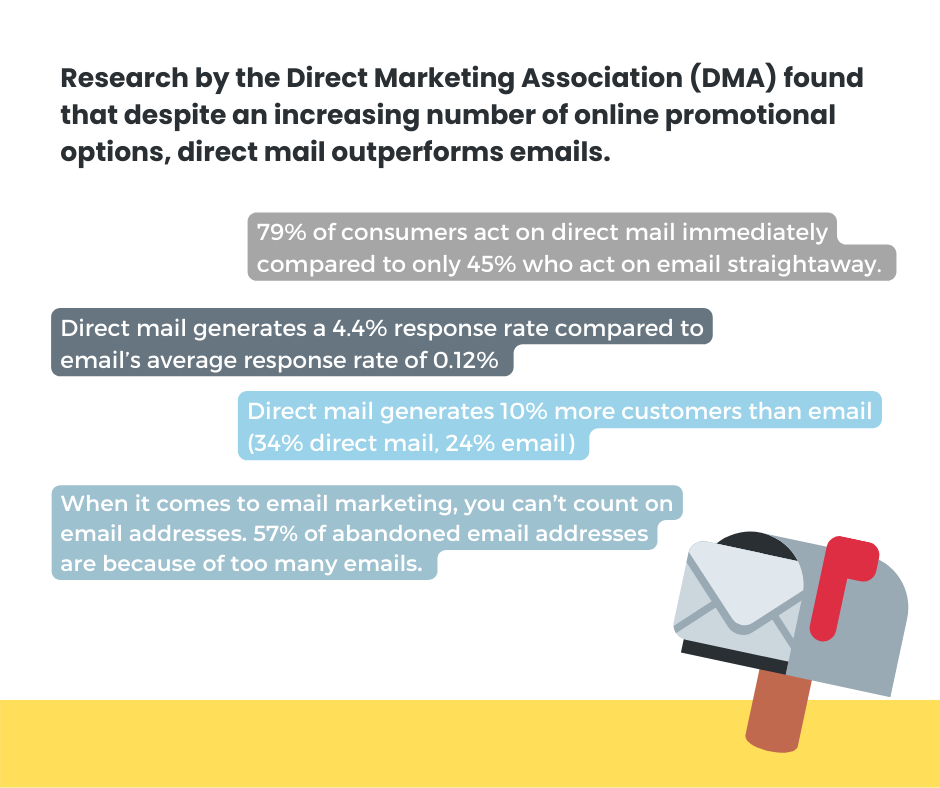Let’s open the discussion between the long-time debate of direct mail versus email and when to use each.
There is a lot of debate and controversy surrounding the topics of email marketing versus direct mail marketing. This article will help to shed some light on some of these differences, as well as their pros and cons.
What is the difference between email marketing and direct mail marketing? And what method works best for reaching your customers in a way that leaves an impression?
It is important to understand the difference between the two so that you can select the most appropriate method for your business.

The term “direct mail” refers to a range of marketing tools, such as sales flyers, postcards, brochures, catalogs, and newsletters. This marketing strategy uses USPS to reach out to current, past, and potential customers who might need your brand’s services. The most successful direct mail pieces? Discounts and coupons!
Email marketing is the practice of utilizing email to send a mass commercial message, typically to a group of customers who have already used your service or have opted in on your site. Email marketing includes but isn’t limited to traditional newsletters, acquisition emails, retention emails, and retail promotional emails.
Direct mail and email are both important marketing tools, but they have some key differences. Let’s review.
The Oversaturated Inbox

We can all agree that we receive way too many emails. In fact, reports show that on average, about 70% of consumers experience a daily influx of emails that make their inboxes full to the brim.
So, as the role of digital media in our life increases, we begin to pay less attention to the messages we are sent.
Email is a powerful tool, but it’s also incredibly crowded. On average, the typical business customer sends or receives 121 emails per day. This oversaturation makes it hard for customers to distinguish spam/sales emails from real ones.
In comparison to direct mail, which has a brand recall of 75%, the average lifespan of an email is about 2 seconds, with only 44% for the brand recall of a digital ad immediately after viewing. (Source: Direct Marketing Association).
As the effectiveness of email begins to decline, let’s see how the growth of direct mail can be used to support it.
Budgeting and ROI
Although the US Postal Service has raised postage prices recently, there are other options available (think servicing through commercial print providers like Solo). These print and mail providers can help businesses reduce their cost of large mailings, making direct mail a relatively affordable option.
The response rate for direct mail is 9% with a house list. For those in the retail industry, 60% of catalog recipients visit the website of a company that sent them a catalog.
Additionally, direct mail recipients purchase 28% more items and spend 28% more money than people who don’t get that same piece of direct mail.
With results like that, direct mail is an essential part of the marketing mix.
Email marketing could be easier to implement and could have a better open rate. Direct mail, however, has shown to produce a higher return on investment.
An email typically yields a $38 return on investment for every $1 invested. The average email lasts two seconds, and 74 trillion emails are sent annually. Email is preferable for making quick money with Flash Sales or larger deals. Compared to traditional mail, email marketing is substantially quicker and less expensive. Although it can reach a huge number of potential customers, many of them are not opened or noticed because of SPAM filters and the fact that most businesses send daily emails.

Benefits of Direct Mail Marketing
When you’re looking to get in touch with your customers, direct mail is the way to go.
Direct mail is one of the only methods of marketing that allows brands to specifically target prospects through location, names, and important, descriptive demographics – including interests! Brands can generate lists that allow them to reach their audience directly at home or their office with a marketing message that impresses.
About 50% of companies report using direct mail in their marketing strategies. That means there is still a lot of room to have your message seen by recipients, in comparison to digital marketing, which about 84% of companies use.
Direct mail is a popular channel among marketers because of its proven ability to generate repeat business and increase customer retention.
On average, repeat customers spend 33% more than new customers! Direct mail is also capable of helping your business turn new, one-time purchasers into loyal customers who not only consistently buy from your business but also provide word-of-mouth referrals.
Direct mail gets noticed: 70% is opened and 79% read for one minute or more. Because direct mail stays in the house for weeks, it’s a more effective way to get your message in front of new customers.
Plus, direct mail can also be used to drive social media, web traffic, and online marketing. Call to actions placed on the designs of direct mail help to encourage users to visit the brand’s website and socials.
Perhaps the “old fashioned” way of reaching customers is not so old fashioned after all. Consider before you discount direct mail as a trendy thing of the past – It is here to stay!

Direct mail is effective because it doesn’t require an opt-in. Unlike email and text messaging, you don’t have to get a recipient’s permission to send them direct mail.
In today’s world, with the rise of digital privacy and the diminishing of online cookies, it’s getting harder and harder to gain access and retarget the online users who have visited your website.
But with direct mail, you don’t have to deal with that issue! The recipient can’t unsubscribe from your mailers or get you in trouble for spamming. Brands can contact someone via direct mail even if they unsubscribed from your email list. Tip: It’s always a good idea to get the physical addresses of those on your email list, so that if they unsubscribe you can still reach them.
B2B and B2C decision-makers, on the other hand, view direct mail as being more reliable than email. Additionally, you can provide a wide range of stuff that fosters trust that isn’t feasible (or reasonable) to send in emails. Yes, you can include links, but direct mail puts the content in front of them in a more immediate and concrete way.
It’s also easier to reach the right person at the right time. Direct mail offers options like kits, dimensional mail, and unique packaging options that, by their nature, get past the gatekeepers. And, unlike email marketing, direct mail doesn’t get a virus or get stuck in the spam inbox!
So, which one should you choose? If you’re looking for long-term results and increased ROI on your marketing efforts, go with direct mail! If you’re still not sure, keep reading.
Benefits of Email Marketing
Email is a powerful tool for reaching your customers. It may not be great for every situation, but it can benefit the right brand at the right time. It’s also a cost-effective solution to reach customers where they visit every day — their inbox. Because of this, brands keep in contact with customers on a consistent basis – sometimes a little too consistent – sending 3 to 4 emails a day to the same customer.
According to Salesforce, 44% of email recipients made at least one purchase last year based on a promotional email.
Most businesses do – and should – use email marketing software to manage their subscriber list and send campaigns.
Using email marketing services, you can also send email campaigns to your subscriber base. It is where the power of email marketing lies. Email is the only way you can have direct contact with your audience online. By adding value to them and earning their trust, you can continually market to them and share your latest offers.
- 91 percent of US adults like to receive promotional emails from companies they do business with. (MarketingSherpa)
- Email is almost 40 times more effective than Facebook, and Twitter combined in helping your business acquire new customers. (McKinsey)
Some of the top benefits include:
- Targeted content that can be personalized
- Segment customers into different lists based on their preferences
- Retailers can reach back out once they leave something in their cart!
- Feature items that are often purchased based off what customers have looked at online
- Create special offers or discounts for their future purchases
- Adjust your message for different audiences
- Build creditability with your customers
- Build brand recognition
- Get access to feedback
This is beneficial for small businesses who don’t have large budgets or a lot of time.
Benefits of Using Direct Mail Marketing and Email Marketing Together
Some of the key takeaways so far include:
- Figure out the right time to utilize the strengths of each platform to achieve goals
- Enhance direct mail by incorporating call to actions that drive traffic to your website.
- Create a lasting impression first with mail, then by sending a reminder email.
So, what are the benefits of using direct mail marketing and email marketing together?
USPS conducted proprietary research that explores a dynamic approach to direct mail.
By implementing an aligned digital marketing strategy with the direct mail campaign, marketers saw 40% conversion rates when the strategies were combined.
The research also shows that 68% of marketing research respondents say the combination of digital and direct mail increases their website visits. In addition, another 60% of respondents shared that the alignment increases the marketer’s return on investment.
By aligning these two channels, your business will utilize an omnichannel campaign that will allow its campaign to further increase its ROI.
Unquestionably, the goal is to grow your brand visibility and attract new prospects across all their personal devices.
It’s time you align your print direct mail campaign with a digital retargeting strategy.
With all the competition, it can be hard to stand out and make a lasting impression. Most people feel that they must choose between two marketing tactics, however direct mail and email marketing can be used together. Both offer unique opportunities when used correctly to improve your business.
Direct Mail Digital Integration
- Mail and email can work to reinforce each other. Brand awareness, increased ROI, customer experience.
- 51% prefer companies to use a combination of mail and email
- 56% say mail makes me feel valued, only 40% say the same about email
- 65% like to browse through both catalog and online before making a purchase
- Customers spend 25% more when businesses use a combination of direct mail and email marketing
- Prospects are 10% to 20% more likely to convert on a direct mail offer.
The power of paper is still here. Use it to your advantage.
When To Use Which Method
Studies show that customers know when they want mail and when they want email.
Top marketing professionals concur that a multi-channel marketing strategy will always perform better than a campaign using only one channel. But occasionally one approach will be superior to the other.
Brochures and catalogs provide a substantial amount of information, which is why we see a 63% increase in customer choice. Similar to loyalty rewards and promotional discounts/coupons.
Check out the graph below to learn more.
You can also check out the link here for the original infographic: https://www.proactive.marketing/direct-mail-vs-email/
Direct mail is a great way to stand out from the crowd. It’s time-tested and cost-effective, so why not give it a try?



